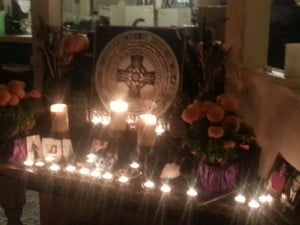Religious stories are about how we as a community can make sense of the ultimate context of our existence. I am not attempting to describe all possible basic religious stories, only those most relevant to our community.
It seems to me what we call “New Age” religions deserve their own category. I am fascinated by how historically modern New Age religions are so closely intertwined with NeoPaganism. At least in the American context they haveintertwined roots sending up vigorous shoots within a liberal largely democratic culture. Elsewhere, particularly central Europe, similar currents–both New Age and Pagan–existed in illiberal contexts. My focus here is the United States. That area is more than big enough for a blog post.
In her fascinating study of American New Age and NeoPagan religion, Sarah Pike observed both New Age and Pagan themes were prominent during the 19th century. Practices we consider New Age today clearly go back to soon after the War of 1812, if not earlier. They continued from then on. There was even a séance room in the Lincoln White House.
Explicitly Pagan themes are far less visible, although tantalizing hints exist, such as Nathaniel Hawthorne’s “The May-Pole of Merrymount” (1836). If Hawthorne’s account touched on real events, the intertwining of New Age and Pagan practices in this country goes back a very long time. Yet today, both NeoPagan and New Age practitioners see themselves as different from one another.
Here is where I think my emphasis on the centrality of story is helpful. The New Age story is one of personal spiritual and social transformation from a messed up present to a wonderful future. It is one of progressive enlightenment. The Pagan story emphasizes the individual’s present life in a spiritual as well as a material community, and the importance of being in harmony with that community. If New Age Americans see history as dominantly linear, NeoPagan Americans see it is dominantly cyclical. Pagans tend to poke fun at what we see as New Age utopianism, and I suspect some New Agers look askance at our lack of interest in big social and religious transformations, at what they see as our spiritual myopia and lack of imagination. Some think we deal too much or entirely with ‘lower’ spiritual realms.
From the first, New Age adherents were deeply and publicly involved in the most progressive democratic movements of their time. From the very beginning, they were supporting women’s suffrage and marriage equality between men and women. They were abolitionists and antiwar activists. Thoreau wrote Civil Disobedience protesting an imperialist war and slavery. His Walden focused on right livelihood. Americans engaged in what we now call New Age spirituality also supported greater respect for the natural world and better treatment of Native Americans. Pagans may or may not have been involved at this time because there is no strong evidence of their organized existence. If present, they were underground.
This contrast can be drawn too starkly. The modern New Age included the late right wing Elizabeth Clare Prophet, while perhaps the best known NeoPagan group is Reclaiming, which has been second to none in supporting protection for nature and social justice. But I think the broad point holds. And any reader of my work knows that I spend considerable time on political topics, so while Pagan I consider them very important.
Some people, usually critics, argue the New Age ultimately has Gnostic roots. If this is true, their ancestors branched off from Pagan traditions in Classical and early Christian times, when a new story emerged. The Gnostic story describes the world being created by a imperfect Demiurge and serving as a trap for souls, who once embodied are unable to return to the perfect realm from which they come. (In the framework I developed in Faultlines, this story is yet one more result of people’s changed relationship with the world within large agricultural civilizations.) Today for the most part, this Gnostic story has little appeal, but it once did. These roots, if they existed, have become very weak. What might remain is a certain ambivalence about the material world as not quite measuring up to spiritual standards, hence their often looking down at Pagan ‘earthiness’.
Far more visibly, New Age adherents have incorporated elements of Hindu and Buddhist religion, as well as Native American and NeoPagan themes, in the process weaving them within a different “New Age” story. This story seems to me the most individualized of any story that can be used to describe a religion, and arguably it is too individualized to serve as the base for a religion.
One significant difference between thisstory and ours is the role of light and darkness, both literally and symbolically. In her demanding but excellent The Wakeful World: Animism, Mind and Self in Nature, Emma Restall Orr makes an insightful comment comparing New Age perspectives with Pagan ones:
Although often mistakenly conflated with animistic Paganism, New Age philosophies and spiritualities tend to be religiously focused on their quest for the light, defining the darkness as the negativity to overcome. . . .
To the animist, a state of perfect enlightenment is not considered natural. . . . Literally and figuratively, in darkness we are denied the safety of certainty. . . . If we are dependent upon knowing, this can leave us confused and fearful. The not-knowing is judged as ignorance; darkness is declared bad, and to be avoided as dangerous. . . .
If, however, our aim is not a knowledge based certainty, what the darkness provides is delicious and necessary release. . . .
Based upon the experience of perceiving nature in his surrounding and immediate environment, the animist doesn‘t work on the assumption of polarities. Crucially, nature appears as tidal not digital. (99-100)
For most NeoPagans, Samhain is as honored as Beltane. Wiccans in particular most often meet when it is dark, when the only light is the full moon, and occasionally meet on the Dark Moon. In temperate zones, Pagan celebrations often seem largely defined by seasonal shifts and the symbolism that accompanies them. Light and life are certainly honored and desired, but so also is the larger context in which they exist, a context that includes darkness and death.
In contrast to many New Age orientations, we have no ascended masters or other superior beings guiding and protecting humanity from serious mistakes. For the most part, the New Age perspective emphasizes that there is a larger context of protective superior beings who will or want to take care of us. We interact with our Gods, but not usually in that way. To my mind New Age traditions tend to be less transcendental and less extreme versions of the common monotheist claim that God has a plan to which we are all contributing, whether we know it or not. It seems to me the Pagan perspective in general is not so anthropocentric as the New Age approach.
In recent decades, many New Age people have thought individual and spiritual transformation is rapidly approaching, and so are attracted to predictions of looming radical change based on things like the Mayan Calendar or the 100th monkey phenomenon. Many Pagans (myself included) called the “Harmonic Convergence” the “Moronic Convergence.” Even so, some Pagans did meditate that day because, like many New Agers, many NeoPagans believe in the power of focused intention. (I was impressed by the fact that within a year of the Harmonic Convergence, the Soviet Union and most of its satellites bloodlessly collapsed. Coincidence or something more? Maybe it was not so moronic.)
Because they do not have sacred texts, central authorities, or long developed traditions of practice, like NeoPagans, New Age boundaries are exceptionally porous. More than seems to be the case in other religions, New Age practices bleed out in many different directions, incorporating aspects of religions that might regard themselves as very distinct from one another. New Age celebrations, ceremonies and teachings often incorporate Pagan, Christian, and Eastern themes, among others. If there is an institutionalized format, to me it seems to be the workshop, where people come together to study with a teacher or learn a skill, meet once or a few times, and return to their individual lives with a new spiritual tool.
Many NeoPagans engage in similar activities, attending the same workshops or drumming circles and the like, but if my framework makes sense, in our religious life we integrate them into a Pagan story or we make them a part of our personal spirituality. I suspect because the New Age is so oriented towards personal spirituality whereas Paganism defines a religious practice, many Pagans are attracted to what it can teach us it in ways not so common in other religions, which have more defined stories and so are harder to integrate. Often New Age insights and practices are as easily integrated into personal spirituality as they are difficult to craft into specific community rituals and celebrations.
Spirituality rather than religion?
Within the framework I am developing, I suggest “New Age religion” constitutes less a religion than a broad spiritual field that has become so diverse in its focus and individualized in its practice as to be unable to generate lasting groups of sustained practice. For example, among the Pagan traditions, New Age culture is particularly attracted to shamanism, but a shamanism conceived mostly or entirely as a path to personal spiritual growth. When I read Carlos Castenada’s books, or one by Lynn Andrews (yes, I did read one), I was struck by their leading spiritual characters’ lack of involvement with the people within their larger community. This is not the case for traditional shamanism. In short, the central role of the community so definitional for religion as I use the term is lacking or undeveloped in New Age circles. Perhaps this is why New Age perspectives can and perhaps must make use of other religions’ frameworks for many of their more collective events.
In conclusion, despite many similarities and considerable overlap at a personal spiritual level, New Age religion is not Pagan. Exploring the differences between their story and ours explains why. We fit similar practices into different patterns within different stories.
I think New Age spirituality, for that is the term I will use now, is very important today. I am not putting it down. Because it appeals to curious people across a broad range of different traditions, and offers workshops and teachers open to all, it is helping (I hope) to strengthen common spiritual connections between people of different religions. In a culture that in so many ways seems to be coming apart at the seams this can serve two important functions.
As we diversify religiously, common New Age spiritual practices shared among people of different religions help us interact within shared spiritual contexts that build friendly bridges between traditions. Some New Agers prefer broadly Pagan frameworks, especially Goddess oriented ones. Some take that perspective into what seems a feminine monotheism. Others are attracted to Christian or Buddhist or other frameworks like mystical Judaism. These differences do not seem to be an issue for anyone within the generic New Age. This is the social side, and on balance, I think it is good.
Second, and relatedly, New Age practices enhance people’s willingness to individualize their spirituality outside of traditional religious frameworks. Frameworks are necessary supports, but they also build walls. The most rigid frameworks erect walls without windows. Our personal spirituality does not tear down the framework of our religion, but it can create more doors and windows, enabling us to look at the wider landscape. This is the individual side, and I think on balance it is also good. It helps remind us that the our story is not the only story (and neither is anyone else’s).
Together these two dimensions promote religious peace and even the celebration of different religions, separate petals on a spiritual flower that exceeds the capacity of any human endeavor to fully encompass. To celebrate differences while being comfortable with who we are is an enormous step beyond simple toleration. It is also one I believe is particularly harmonious with a Pagan perspective.
















